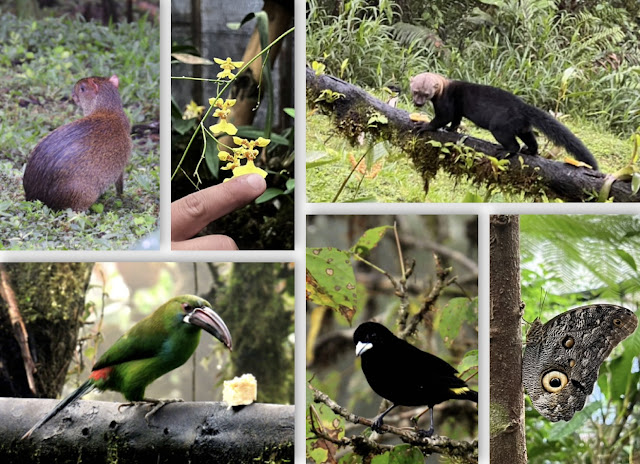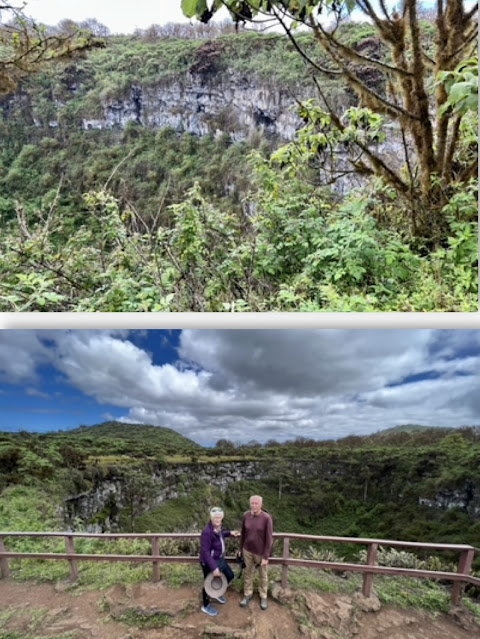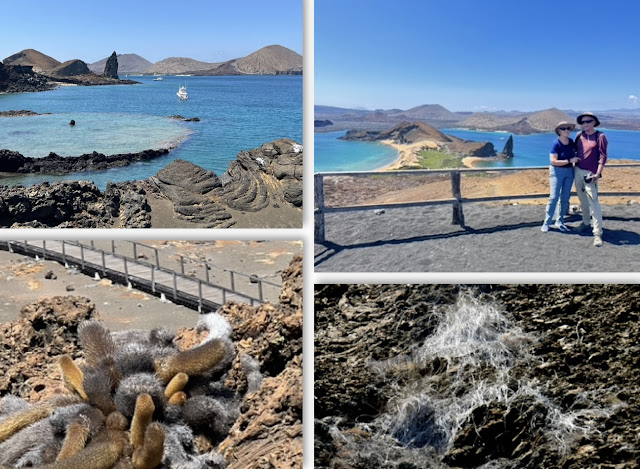We moved on to lower, warmer climes in Guayaquil. The drive through the Cajas National Park (where we had hiked a few days before) included a steep, narrow section of detour in an area that had been closed due to a landslide. Quite scary but we knew our driver had done it the day before, so we were fairly confident all would be fine.
We stopped for lunch after we reached lower altitudes. Pat thoroughly enjoyed the fried whole Covina she had for lunch. Note: The round yellowish bits on the top left of the plate are the traditional fried banana slices we had throughout our stay in Ecuador. We failed to appreciate them, to us they were just dry, mildly flavored fried bits, not worth the calories.
Guayaquil's major draw is it's airport, ie it is mainly a transportation hub. But we decided to stay a few days to check out the city. In recent years, the waterfront area has been seriously renovated from a slum to The Malecón (a waterfront promenade) with high rise hotels & apartments, restaurants, art galleries, an amusement park with a giant wheel, a shopping center and more.
It turned out to be an interesting time to visit to experience their unique New Year's customs.
One we heard of and saw one such incident, the New Year Viudas (widows of the old year). For this, men dress-up in drag, using balloons to enlarge their bosoms, and wearing high heels, short skirts and female wigs. They then stop traffic to ask for small donations to fund their NY Eve parties.
Another involves making or buying effigies (known locally as Manigotes) of politicians, celebrities and cartoon characters. The effigies are made from papier-mache and stuffed with paper and fireworks. They represent the Año Viejo (the old year). These are burned a midnight to leave behind all of the trials and tribulations of the previous year and welcome better luck in the coming one.
And of course there are firework shows, some organized by the city and others start after midnight when hundreds of small family displays erupt across the city often lasting into the wee hours of New Year’s Day.
Our city tour took us along a route with a wide variety of Manigotes for sale. They are displayed in many ways in the days leading up to New Year. In Parque Seminario, a street cleaner had one on his cart. And we saw them on cars.
Our first tour stop was Mirador Cerro Paraiso with views to the east of city and the river as well as of a few birds including a Saltator maximus (top right below) and a Blue-gray tanager (bottom center). Later at the Plaza de la Administración we encountered a flock of Red-masked parakeets. The Parque Semenario is known for the many Green Iguanas that live there. They like bananas and the park staff leave a stash to feed them. Before returning to the hotel we stopped to see the 40 foot tall Monkey Machín Sculpture. Consisting of 110,000 ceramic tiles, the statue is based on the monkey in a children's story.We enjoyed an excellent lunch at La Regatta Comida de Mar at the north end of the Malecón near our hotel. Our starter was Pear salad infused in red wine, mixed leaves, smoked almonds, parmigiano reggiano (24 months), balsamic vinaigrette, and strawberries. The main was Grilled fish of the day with mashed potatoes (achiote, beet, cauliflower and broccoli, oyster mushrooms, asparagus, black leek sauce accompanied by chips
Later we picked up some snacks and Prosecco to celebrate the New Year.
New Years Day was clear and not as unbearably hot as expected. Around 9am we headed out to climb the 444 steps (numbered on the right hand side) up Santa Ana Hill to El Faro (lighthouse), a Chapel and Naval Museum.Along the way we passed restaurants, cafes, art galleries, internet cafes and craft shops. At the top there are great views. The museum looked closed but as we peered in to check it out, the security guard came over and unlocked the gate for us. We were very glad we did this climb early as it got much hotter.





















































